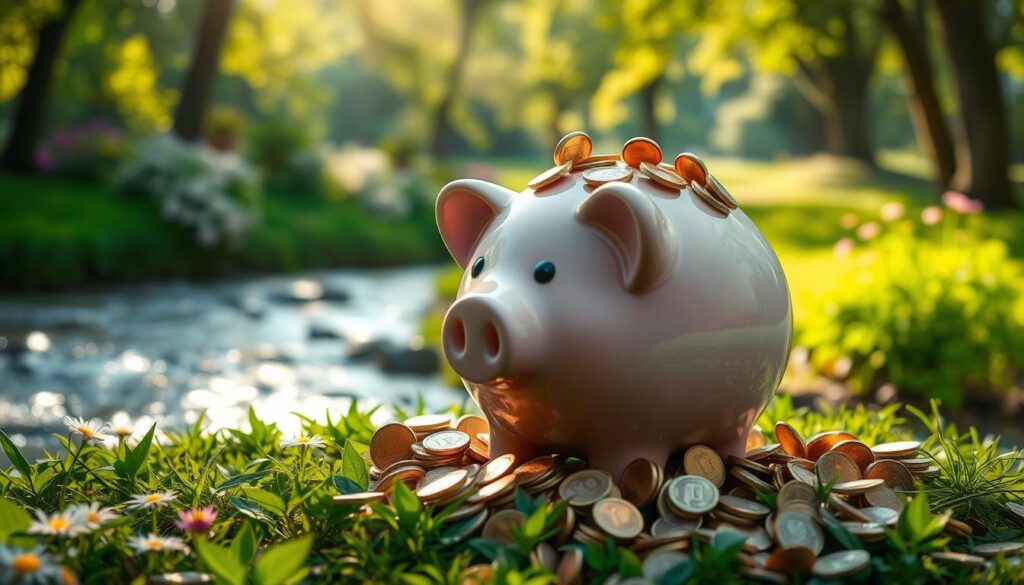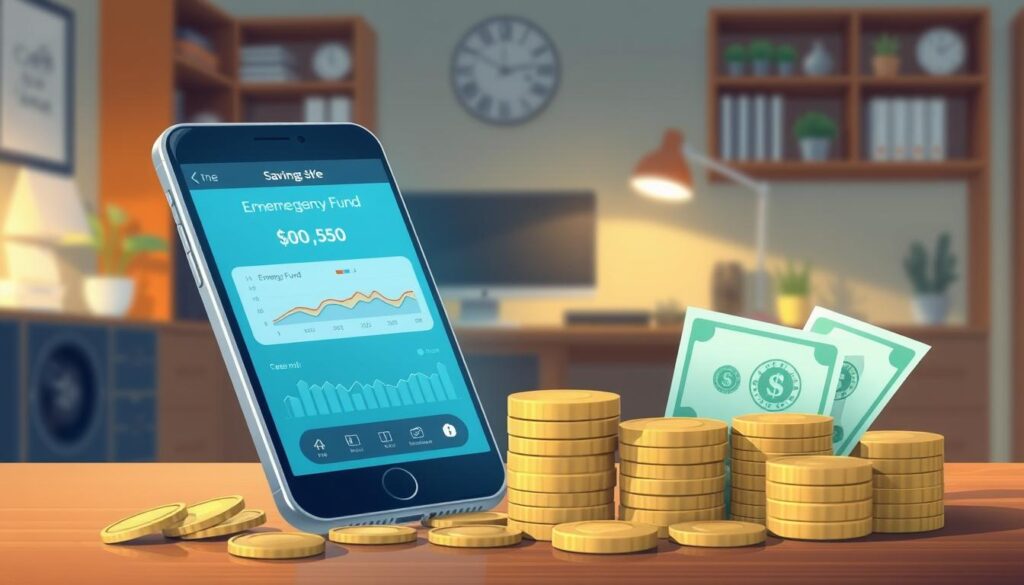
In Nigeria’s changing financial world, having a strong emergency fund is key. It acts as a safety net against sudden costs, job losses, or other life surprises. This fund helps keep your finances stable.
This article will show you how to create a solid emergency fund plan. We’ll cover what an emergency fund is, why it’s important, and how to figure out how much you need. We’ll also talk about where to keep your savings and how to keep it growing.
Key Takeaways
- An emergency fund is a crucial component of a comprehensive financial plan, providing a safety net for unexpected expenses and life events.
- Calculating your emergency fund goal based on your unique financial situation is essential to ensure adequate coverage.
- Budgeting, saving, and exploring additional income streams can help you build your emergency fund more efficiently.
- Keeping your emergency savings in a high-yield savings account can help your money grow while remaining accessible.
- Regularly reviewing and adjusting your emergency fund as your life circumstances change is key to maintaining financial security.
What is an Emergency Fund?
An emergency fund is a special savings account for unexpected costs. This could be medical bills, car repairs, or losing your job. It acts as a financial safety net, helping you avoid financial setbacks and keep your long-term goals on track.
Defining an Emergency Fund
An emergency fund is a savings account you can use when unexpected things happen. It helps you deal with financial crises without using high-interest debt. Its main goal is to ensure you can handle sudden expenses without losing your financial stability.
Importance of Having a Rainy Day Fund
Having a rainy day fund is key to financial stability. Unexpected costs can quickly use up your savings, causing financial stress if you’re not prepared. A financial safety net helps you manage these situations smoothly, reducing stress and allowing you to focus on solving the problem.
In short, an emergency fund is vital for a solid financial plan. It gives you the financial resilience to handle life’s surprises and keep your long-term goals in sight.
“An emergency fund is the foundation of a strong financial plan. It provides a crucial safety net for unexpected expenses, allowing you to weather life’s storms without compromising your long-term financial objectives.”
Calculating Your Emergency Fund Goal
Finding the right size for your emergency fund is key to financial stability. To figure out your emergency fund goal, think about your monthly bills, income, and any special financial needs you have.
Experts suggest aiming for an emergency fund that can last 3 to 6 months. This should cover basic needs like rent, utilities, food, and other essential costs. Having a clear goal helps you build a strong savings cushion for unexpected times.
- Keep track of your monthly budgeting and expenses to find your average costs.
- Consider any financial planning factors, like irregular bills or medical costs.
- Then, multiply your monthly essential costs by 3 to 6 months to find your emergency fund goal.
Your emergency fund size should match your personal finance needs. Check and update your emergency fund goal as your life changes. This keeps your financial safety net strong.
“Building an emergency fund is one of the most important steps in financial planning. It provides a buffer against unexpected expenses and helps you avoid dipping into long-term savings or taking on debt.”
Sources to Build Your Emergency Fund
Building an emergency fund is key to financial security. But, it’s hard to know where to start. Luckily, there are many ways to add to your rainy day savings.
Budgeting and Saving Strategies
One great way to grow your emergency fund is to make a detailed budget. Look closely at your monthly spending and cut back on things you don’t need. This frees up money for your savings. Also, set up automatic savings to keep it consistent.
- Analyze your monthly budget and identify areas for cost-cutting
- Automate your emergency fund contributions to make saving a habit
- Explore ways to reduce expenses, such as negotiating bills or cutting subscriptions
Side Hustles and Additional Income Streams
Another smart move is to find side hustles or extra income. Use some of this extra money for your emergency fund. This can help it grow faster. Think about freelance work, selling online, or a part-time job.
- Identify skills or hobbies that could be monetized as a side hustle
- Explore online marketplaces or platforms to offer your services or products
- Allocate a portion of your side hustle income directly to your emergency fund
By using budgeting, saving, and side hustles, you can build a strong emergency fund. This protects your financial future.
| Strategy | Potential Benefits | Considerations |
|---|---|---|
| Budgeting and Saving |
|
|
| Side Hustles and Additional Income |
|
|
“The key to building a strong emergency fund is to combine smart budgeting with creative income-generating strategies. By exploring multiple avenues, you can accelerate your savings and achieve greater financial resilience.”
Where to Keep Your Emergency Fund
It’s important to pick the right spot for your emergency fund. A high-yield savings account is a great choice. It offers easy access and a bit of interest, keeping your savings safe and ready for when you need them.
High-Yield Savings Accounts
High-yield savings accounts give you a better interest rate than regular savings accounts. They offer rates between 2% to 3% APY, much higher than the national average of about 0.10%.
Keeping your emergency fund in a high-yield savings account has many benefits:
- Accessibility: You can quickly get to your liquid assets in case of an unexpected expense, keeping your financial stability.
- Competitive Rates: The higher interest rates help your emergency fund storage grow, making your savings work harder for you.
- FDIC Insurance: Your funds are usually covered by federal deposit insurance, adding extra protection to your emergency fund.
Choosing a high-yield savings account for your emergency fund balances accessibility with modest returns. This ensures your rainy day fund is there for you when you need it most.
Emergency Fund Strategies
Having a solid emergency fund is key to financial planning and staying strong. An emergency fund is there to help when unexpected things happen. We’ll look at different ways to keep your emergency fund strong and ready when you need it.
Automate Your Contributions
One great way to grow your emergency fund is to automate your contributions. Set up automatic transfers from your main account to your emergency fund. This way, you make sure a part of your money always goes to your emergency fund, helping you stay on track.
Diversify Your Emergency Fund
While keeping your emergency fund in a savings account is important, you can also think about investing. Diversifying your emergency fund by adding some investments can help it grow. Consider putting a bit into money market funds or short-term bonds for a chance at growth while still keeping it easy to access.
Establish a Replenishment Plan
If you use your emergency fund, it’s important to have a plan to replenish those funds quickly. You might need to adjust your budget, find extra work, or move money from other savings goals. Keeping up with this plan helps keep your financial strength up.
By using these emergency fund strategies, you can keep your financial planning and money management on track. This will help you stay ready for life’s surprises.
Maintaining and Replenishing Your Emergency Fund
Keeping your emergency fund strong is key. It helps you face unexpected money problems. By following a strict plan, you can keep your fund full and avoid using it for things you don’t need.
Automating Contributions
Automating your savings is a smart move. Set up automatic transfers from your paycheck to your emergency fund. This way, you save regularly without having to think about it.
- Automate transfers from your checking account to your emergency fund savings account.
- Schedule regular contributions, such as a fixed percentage of your paycheck or a predetermined monthly amount.
- Review and adjust your emergency fund maintenance contributions as your financial situation changes.
Automating your savings makes it easy to grow your replenishing emergency fund. You won’t have to worry about making transfers yourself, keeping your safety net full.

“Automating your emergency fund contributions is a game-changer. It takes the guesswork out of saving and ensures your rainy-day fund is always ready when you need it.”
Remember, keeping your emergency fund in good shape is crucial. Make it a regular part of your life. This way, you’ll always have peace of mind knowing your emergency fund is ready for you.
Common Emergency Fund Mistakes to Avoid
Having an emergency fund is key to good financial planning and money management. But, even careful people can make mistakes that hurt their emergency fund. We’ll look at some common errors to help you build a strong financial safety net.
One big mistake is using your emergency fund for things you don’t really need. It might be tempting to spend it on something fun or to upgrade your lifestyle. But, it’s important to keep your emergency fund safe for real emergencies. Using it for non-essential things can quickly drain it, leaving you without money when you really need it.
Another mistake is not putting money back into your emergency fund after you use it. It’s important to work on rebuilding it to its original amount. If you don’t, you might not have enough money saved when you really need it.
- It’s also important to regularly check and adjust how much money you have in your emergency fund. As your money situation changes, so might your emergency fund needs. Not updating it can mean you either don’t have enough or have too much money in low-earning accounts.
- Finally, not being disciplined with your money can hurt your emergency fund. Spending on impulse, not budgeting well, and not following good money management habits can quickly use up the money you’ve saved.
By avoiding these common mistakes, you can make sure your emergency fund is strong and ready for any unexpected problems. This will help protect your financial future.
Tax Implications of Emergency Funds
Building an emergency fund is important. You need to know how taxes affect your savings. The structure and use of your fund can change your taxes and personal finance.
Think about tax-deferred growth. High-yield savings or money market funds might be taxed. But, a Roth IRA can offer tax-free growth and withdrawals in hard times.
Withdrawal taxes depend on the account and reason. Regular savings account withdrawals are taxed. But, Roth IRA withdrawals for emergencies might not be taxed, under certain conditions.
| Account Type | Tax Implications of Withdrawals |
|---|---|
| Regular Savings Account | Withdrawals are considered taxable income. |
| Roth IRA | Withdrawals for qualified emergencies may be tax-free. |
Knowing about emergency fund taxes helps you manage better. It ensures your financial planning works for you. By understanding taxes, you can get the most from your fund and avoid extra taxes.
“Building an emergency fund is a crucial step in personal finance, and understanding the tax implications is key to making the most of your savings.”
Emergency Fund vs. Other Savings Goals
Building an emergency fund is key, but it’s not the only goal. You also need to think about retirement, paying off debt, and investing for the future. It’s important to balance these goals for a strong financial plan.
Prioritizing Your Financial Goals
When saving, think about what’s most important to you. Here are some tips to help:
- Figure out how much you need in your emergency fund. This depends on your spending and lifestyle.
- Make sure you’re saving enough for retirement. This includes taking advantage of employer matches and tax benefits.
- Focus on paying off high-interest debt first. This can really help your financial health.
- Set aside some money for long-term investments. This could be in stocks or real estate.
- Check your savings goals often. Change your plan as your life changes.
By balancing your emergency fund with other goals, you can make a solid financial plan. This plan will cover both your short-term and long-term needs.
| Savings Goal | Recommended Allocation |
|---|---|
| Emergency Fund | 3-6 months of living expenses |
| Retirement | 10-15% of annual income |
| Debt Repayment | Prioritize high-interest debt |
| Long-Term Investments | Remaining discretionary income |
Remember, your financial goals can change over time. It’s crucial to keep checking and adjusting your savings plan. This ensures it meets your current needs and goals.

Case Studies: Emergency Funds in Action
The power of an emergency fund shines through real-life stories. These tales show how a rainy day account keeps finances stable during tough times.
Sarah, a young professional in Lagos, faced a big challenge when COVID-19 hit. Her work hours were cut, and her income fell. But thanks to her emergency fund, she could pay her bills for months without touching her savings or getting into debt.
The Martinez family also benefited from their emergency fund. When Mr. Martinez lost his job, the family used their savings to stay afloat. This let them search for new jobs without worrying about money.
| Case Study | Challenge Faced | How the Emergency Fund Helped |
|---|---|---|
| Sarah, Lagos | Reduced work hours and income during COVID-19 pandemic | Covered essential expenses for several months without dipping into long-term savings or taking on debt |
| Martinez Family | Job loss due to company downsizing | Allowed the family to focus on finding new employment opportunities without the added stress of unexpected expenses |
These emergency fund case studies highlight the importance of financial security. They show how being prepared for the unexpected can bring peace of mind. With a solid emergency fund, people and families can handle life’s surprises better.
Adjusting Your Emergency Fund Over Time
As your financial situation and life circumstances change, it’s important to check and adjust your emergency fund. This keeps your safety net strong against unexpected challenges.
When it comes to emergency fund adjustments, consider these strategies:
- Reevaluate your financial planning and lifestyle changes: Watch for changes in your income, expenses, and personal life. This could be a new job, a family member, or moving. These life changes might mean you need to adjust your emergency fund.
- Adjust your savings strategies accordingly: If your income goes up, think about adding more to your emergency fund. If your expenses increase, you might need to use money from other savings goals to keep your emergency fund strong.
- Remain vigilant and flexible: Keep an eye on your emergency fund size and how you’re using it. Be ready to make adjustments as your financial situation changes to keep your security.
| Scenario | Emergency Fund Adjustment |
|---|---|
| Job loss or reduced income | Increase emergency fund contributions to cover extended unemployment |
| New home purchase or relocation | Expand emergency fund to accommodate higher expenses |
| Growing family | Increase emergency fund to cover additional dependents |
By being proactive and flexible with your emergency fund adjustments, you can keep your financial safety net strong. This gives you the protection and peace of mind you need, no matter what life brings.
“An ounce of prevention is worth a pound of cure. Maintaining a well-funded emergency account can make all the difference when unexpected events arise.”
Conclusion
Building a strong emergency fund is key to a solid financial plan. By following the strategies in this article, you can create a safety net. This will help you face unexpected financial challenges and protect your future in Nigeria.
A good emergency fund brings peace of mind and financial strength. It lets you focus on your long-term goals with confidence. Making an emergency fund a priority is wise for securing your financial future, especially in uncertain times.
Whether you’re starting or improving your emergency fund, this article offers valuable advice. By applying the principles of emergency fund planning, you can manage your finances well. This will lay a solid foundation for a prosperous future in Nigeria.





